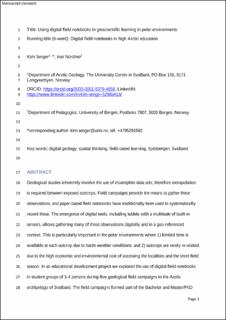Using digital field notebooks in geoscientific learning in polar environments
Journal article, Peer reviewed
Accepted version
Permanent lenke
https://hdl.handle.net/11250/2993231Utgivelsesdato
2021Metadata
Vis full innførselSamlinger
- Department of Education [296]
- Registrations from Cristin [9489]
Originalversjon
Journal of Geoscience Education (JGE). 2021, 69 (2), 166-177. 10.1080/10899995.2020.1725407Sammendrag
The emergence of digital tools, including tablets with a multitude of built-in sensors, allows gathering many geological observations digitally and in a geo-referenced context. This is particularly important in the polar environments where (1) limited time is available at each outcrop due to harsh weather conditions, and (2) outcrops are rarely re-visited due to the high economic and environmental cost of accessing the localities and the short field season. In an educational development project, we explored the use of digital field notebooks in student groups of 3–4 persons during five geological field campaigns in the Arctic archipelago of Svalbard. The field campaigns formed part of the Bachelor and Master/PhD courses at the University Centre in Svalbard in Longyearbyen at 78°N. The digital field notebooks comprise field-proofed tablets with relevant applications, notably FieldMove. Questionnaires and analyses of students’ FieldMove projects provided data on student experience of using digital field notebooks, and insight into what students used the digital notebooks for, the notebooks’ functionality and best practices. We found that electronic and geo-referenced note- and photo-taking was by far the dominant function of the digital field notebooks. In addition, some student groups collected significant amounts of structural data using the built-in sensors. Graduate students found the ability to conduct large-scale field mapping and directly display it within the digital field notebook particularly useful. Our study suggests that the digital field notebooks add value to field-based education in polar environments.
